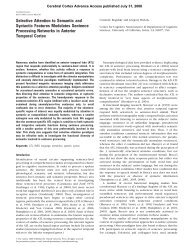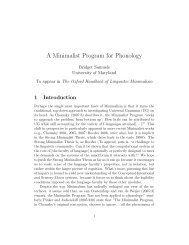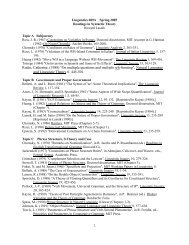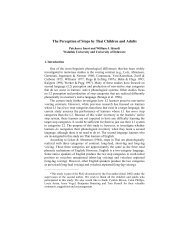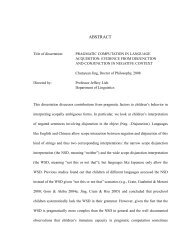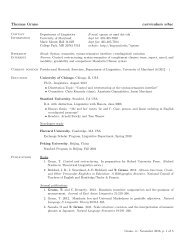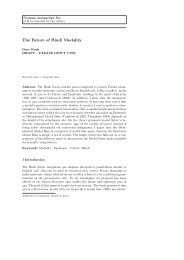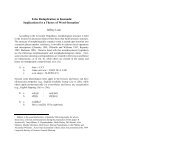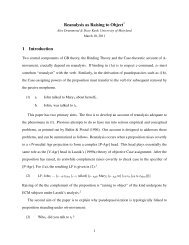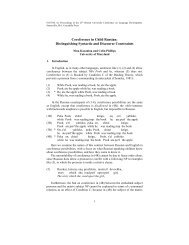AGREEMENT ASYMMETRIES IN MODERN STANDARD ARABIC ...
AGREEMENT ASYMMETRIES IN MODERN STANDARD ARABIC ...
AGREEMENT ASYMMETRIES IN MODERN STANDARD ARABIC ...
Create successful ePaper yourself
Turn your PDF publications into a flip-book with our unique Google optimized e-Paper software.
<strong>AGREEMENT</strong> <strong>ASYMMETRIES</strong> <strong>IN</strong> <strong>MODERN</strong> <strong>STANDARD</strong> <strong>ARABIC</strong>AND THE φ-FEATURES OF TRACESMART<strong>IN</strong> WALKOWThe Problem. Modern Standard Arabic (henceforth MSA) shows two kinds asymmetriesin subject verb agreement (see e.g. Fassi Fehri, 1988). The first asymmetry I will call theSubject Type Asymmetry. While pro and full pronominal subjects in postverbal positiontrigger verbal agreement in gender and number (henceforth full agreement), full DP subjectsonly trigger gender agreement (henceforth partial agreement), as illustrated in (1) vs (2).(1) qaraP{ -at/ *-na/ *-a } Pal fatayæ:t -u Pal dars -aread.perf{ -3s.f/ *-3p.f/ *-3s.m } def girls -nom def lesson -acc‘The girls read the lesson.’ (adapted from Soltan, 2007, 35)(2) Ãæ:P -u: hum læ: Pæ:bæ:P -u -humcome.perf -3.p.ma they neg fathers -nom -their‘They came, not their fathers.’ (Soltan, 2007, 41)I will argue for an account of these facts based on differences between pronouns and full DPswith respect to how number and gender are syntactically represented in them.The second asymmetry concerns the the position of verb and subject with respect to eachother: preverbal subjects, both pronouns and full DPs, trigger full agreement, as in (3).(3) Pal Paulæ:d-u qadim{ *-a / -u: }def boys came{ -3sg.masc / -3pl.masc }‘The boys came.’ (Harbert and Bahloul, 2001, 45)That is the Subject Type Asymmetry disappears once the subject precedes the verb. I willcall this the Positional Asymmetry.One line of approaches attributes the Positional Asymmetry to clitic left dislocation (e.g.Plunkett, 1993; Soltan, 2007), assimilating the full agreement in (3) to that in (2) combinedwith pro-drop. A second line (Bahloul and Harbert, 1992; Aoun et al., 1994) attributesthe positional asymmetry to properties of Specifier-Head agreement. I present empiricalarguments from embedded contexts against both the clitic left dislocation approach and thespecifier head approach, showing that not all preverbal subjects are left dislocated, not allpreverbal subjects bind resumptive pronouns and not in all instances of preverbal subjectsis there a specifier which they have plausibly moved through to agree with the verb. I argue1
2 MART<strong>IN</strong> WALKOWthat when the subjects precede verbs as in (3), the φ-features on the verb come from an A’-trace of the subject below the verb, not from the preverbal DP. The Positional Asymmetryarises from different φ-features being available lexical DPs and in A’-traces, where A’-tracesand pronouns share the same features.The Subject Type Asymmetry. I assume that subject verb agreement is established by afunctional head probing for a categorical D-feature. The exchange of φ-features between goaland probe is parasitical on this relation. Only the features present on the goal D-head arevalued on the probe. The Subject Type Asymmetry arises from different sets of φ-featuresbeing present in the D-heads of pronouns vs full DPs. While pronouns are syntactically justD-heads and contain the full set of φ-features, the D-heads of full DPs acquire their φ-featuresvia agree. I assume that D probes for a categorical N-feature, valuing of φ-features is againparasitical on this agree relation. I follow Ritter (1995, and earlier work) in assuming thatnumber in NPs is associated with a separate projection (Num), while gender specificationis intrinsic to the head noun. Constructions where agree between D and N results inmovement (construct states and names) show that the goal of the agree-relation is thehead noun, excluding the number projection. It follows that the only feature present in theDs of full DPs is gender. The different agreement relations are illustrated in (4)(4) a. Pronoun: V " #gen...[ D " gennum numb. Full DP: V [gen] ...[ D [gen] [ Num [num] [ N [gen] ]]]#]The Positional Asymmetry. The Positional Asymmetry arises from different featuresbeing available in full DPs and A’-traces. I follow (i) Fox (1999, 2002) and Sauerland (2004)in assuming that A’-movement involves a process of Trace Conversion, which replaces theD-head of the copy in the base position with an indexed determiner, and (ii) that syntacticindexes contain φ-features as argued in Kratzer (2002, 2008). The indexed determiner createdby trace conversion has the full set of φ-features like a pronoun.This account raises the question of why the φ-features on verbs are those after TraceConversion, as opposed to those of the full DP that was the original goal. I present firststeps towards an explanation that builds on fact that the operation agree consists of twosteps: match and value. If match applies before Trace Conversion and value after it, itfollows that the probe shows the φ-features of the trace.ReferencesAoun, J., Benmamoun, E., and Sportiche, D. (1994). Agreement, word order and conjunctionin some varieties of Arabic. Linguistic Inquiry, 25(2):195–220.
<strong>AGREEMENT</strong> <strong>ASYMMETRIES</strong> <strong>IN</strong> <strong>MODERN</strong> <strong>STANDARD</strong> <strong>ARABIC</strong> AND THE φ-FEATURES OF TRACES3Bahloul, M. and Harbert, W. (1992). Agreement asymmetries in Arabic. In Proceedings ofthe Eleventh West Coast Conference on Formal Linguistics.Fassi Fehri, A. (1988). Agreement in arabic, binding and coherence. In Barlow, M. and Ferguson,C. A., editors, Agreement in Natural Language, Approaches, theories, descriptions,chapter 6, pages 107–158. CSLI.Fox, D. (1999). Reconstruction, binding theory , and the interpretation of chains. LinguisticInquiry, 30(2):157–196.Fox, D. (2002). Antecedent-contained deletion and the copy theory of movement. LinguisticInquiry, 1(33):63–96.Harbert, W. and Bahloul, M. (2001). Postverbal subjects in arabic and the theory of agreement.In Ouhalla, J. and Shlonsky, U., editors, Themes in Arabic and Hebrew Sytnax,pages 45–70. Kluwer Academic Publishers.Kratzer, A. (2002). The event argument.Kratzer, A. (2008). Making a pronoun. fake indexicals as windows into the properties ofpronouns. Ms. Semantics Archive, To appear in Linguistic Inquiry.Plunkett, B. (1993). The position of subjects in Modern Standard Arabic. In Eid, M.and Holes, C., editors, Perspectives in Arabic Linguistics V, Papers from the fifth annualsymposium on Arabic Linguistics, pages 231–260. John Benjamins, Amsterdam.Ritter, E. (1995). On the syntactic category of pronouns and agreement. Natural Language& Linguistic Theory, 13:405–443.Sauerland, U. (2004). The interpretation of traces. Natural language & Linguistic theory,12:63–127.Soltan, U. (2007). On Formal Feature Licensing in Minimalism: Aspects of Standard ArabicMorphosyntax. PhD thesis, University of Maryland.



